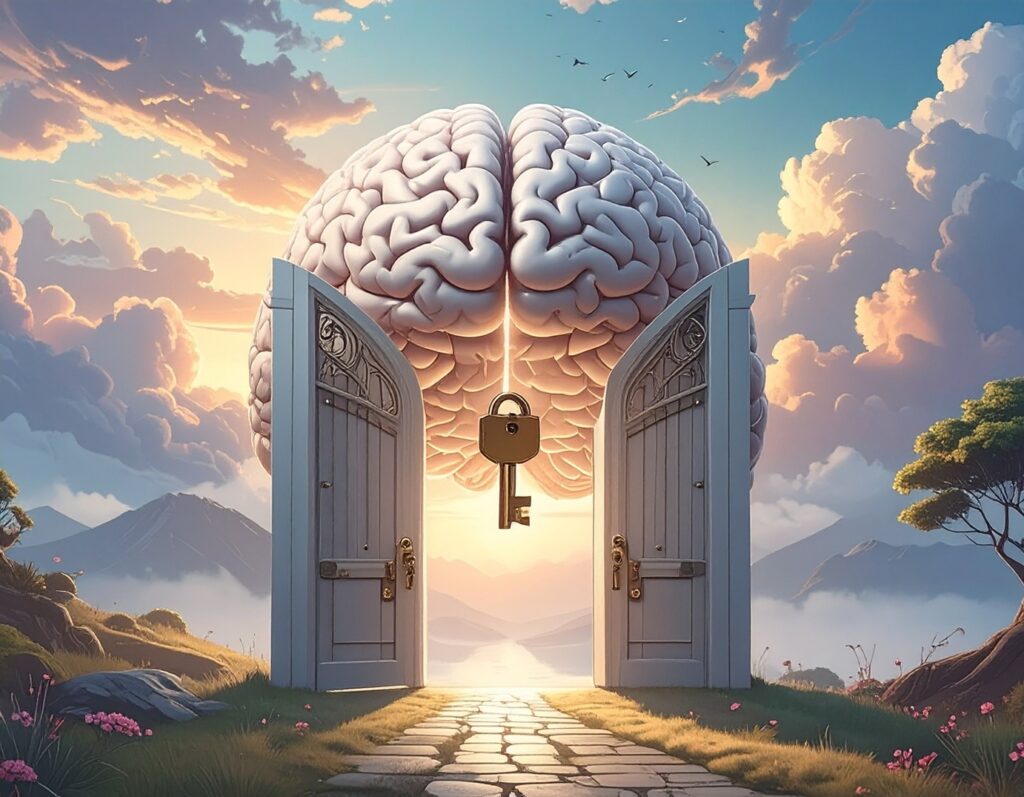This post is also available in Dutch.
In a previous blog, we discussed the concept of working memory gating: the brain’s mechanism for deciding which information enters or exits our mental workspace. As described there, a deep part of our brain, called the basal ganglia, and the front part, called the prefrontal cortex (PFC), work together to open and close these gates, deciding which information is useful for guiding our behavior. But how exactly does this work? Studies show that dopamine, a chemical messenger in the brain, helps to open and close the gates to working memory.
Dopamine opens the gate
The basal ganglia and PFC are connected via a loop that determines whether information is admitted into working memory or kept out. This circuit relies on dopamine to influence these decisions: brief, phasic bursts of dopamine in the basal ganglia are thought to signal when to “open the gate,” allowing new information to be stored in the PFC or to selectively reactivate information currently stored in working memory. In contrast, when static dopamine levels are low, our brain preserves existing representations, protecting them from distractions. This flexible switching between updating and stability is vital for everyday tasks. Without dopamine fine-tuning, our working memory would either be too rigid (never updating) or too chaotic (constantly overwritten). This might sound abstract, but imagine you are biking to work. Most of the route will feel automatic because you take it every day. Usually, lower dopamine levels help you stay focused on the road ahead while keeping out irrelevant distractors. But today, a construction zone appears: A dopamine burst acts as the signal to update your working memory with new information so you can change your path.
Behind the gate: Memory in PFC and sensory cortex
Once information is let into working memory, the representations don’t only live in the PFC. Increasing evidence suggests that the relevant sensory cortices (such as visual areas when remembering an image) work together with the PFC to maintain information in working memory. This interplay is thought to rely on the unique microstructure of the brain’s cortex, in which the different layers have their own roles. Superficial layers pass incoming information up the hierarchy (so from visual cortex to prefrontal cortex when new information comes in) while deep-layer connections go the other way when information needs to be reactivated.
Zooming in with ultra-high field MRI
The layer specificity explained above could be a key mechanism by which dopamine operationalizes stability and flexibility of working memory representations. This may be because dopamine receptors are more common in deeper layers compared to superficial layers. Current research uses ultra-highfield fMRI, able to capture the “activity” in layers, to investigate this relationship between dopamine and working memory gating. In the study, healthy volunteers receive either a medication that interacts with dopamine or a placebo and then perform a working memory task in the 7T MRI scanner at the Erwin-Hahn Institute*. Interested in participating? Contact dopaminememory@donders.ru.nl for more information.
Conclusion
To summarize, dopamine is more than a “pleasure hormone”: it is a gatekeeper for the information that drives our thoughts and actions. By modulating activity across cortical layers, dopamine helps us create the right balance between stability and flexibility in working memory. Understanding this dynamic not only helps us understand how our brains solve complicated tasks in the face of distraction but also opens new directions for studying disorders characterized by deficits in dopamine. Next time you effortlessly switch attention in traffic, remember: that’s dopamine at work
*The Erwin-Hahn Institute is a collaboration of Radboud University and the University of Duisburg-Essen and houses a 7T Siemens Magnetom Terra system at the Zeche Zollverein Essen, a World Heritage Site.
Credits
Author: Helena Olraun
Buddy: Dirk-Jan Melssen
Editor: Vivek Sharma
Translation: Lucas Geelen
Editor translation: Wieger Scheurer
Image created with Adobe firefly
